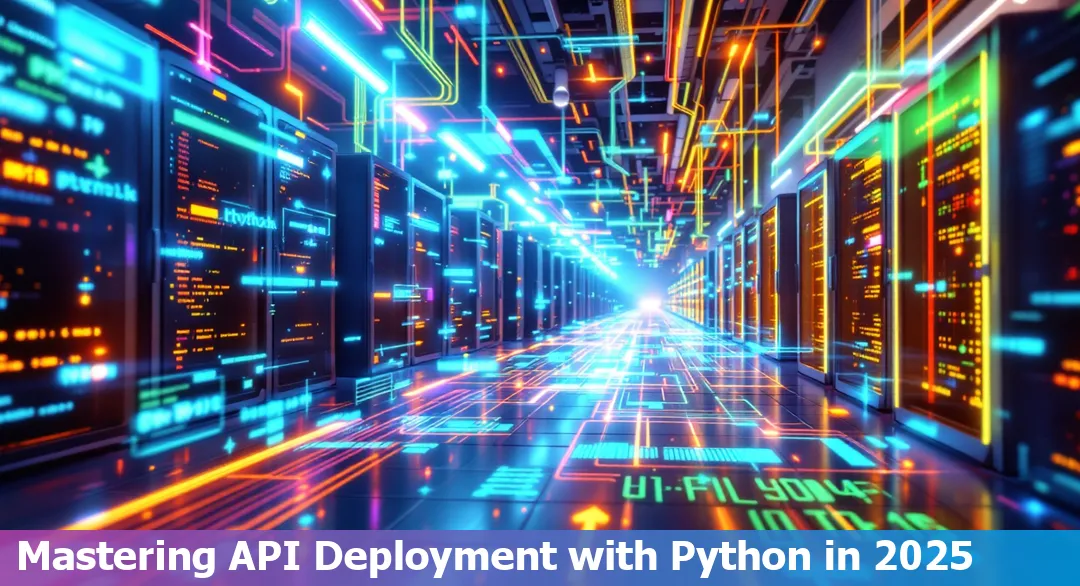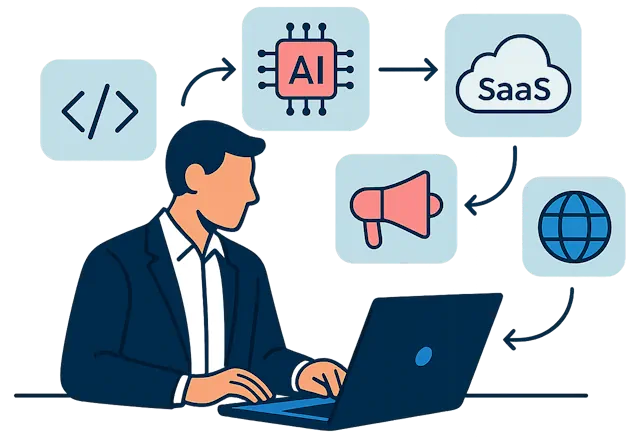Deploying and Managing APIs with Python: Strategies for Scale in 2025
Last Updated: March 24th 2025

Too Long; Didn't Read:
In 2025, deploying and managing APIs with Python focuses on scalability, leveraging frameworks like FastAPI and Django. Key strategies include using JSON, error handling, in-memory caching with Redis, and microservices architecture. Trends like API-first development, zero-trust security, and AI integration enhance performance and security. Utilizing tools like Prometheus, Swagger, and AI-powered platforms improve automation, documentation, and efficiency. Choose between REST, GraphQL, and gRPC based on project needs for optimal API performance and user experiences.
As we head into 2025, API scalability is getting seriously complex. According to recent findings, environments are becoming more challenging than ever, especially with the surge in data-intensive applications.
Python continues to crush it in the API development scene, with its frameworks making life easier for developers like me. What's really interesting is that by 2025, API standards will be crucial for creating scalable, interoperable systems.
I've been using Python's FastAPI and Django frameworks, and honestly, they're amazing for handling heavy workloads. The coolest part? Gartner predicts that 50% of APIs will be unmanaged by 2025, which makes understanding proper API management super important.
When you're building APIs with Python, you get access to this incredible ecosystem of libraries, plus the community is always there to help when you're stuck.
The integration with AI tools is getting better every day, making it possible to automate more tasks and handle larger amounts of data. Trust me, if you're planning to build scalable APIs, Python is definitely the way to go.
Table of Contents
- API Trends and Technologies in 2025
- Strategies for Scaling Python REST APIs
- API Design and Development Best Practices
- Tools and Techniques for API Deployment
- Frequently Asked Questions
-
Explore the future with emerging microservices and serverless architecture trends influencing backend development.
API Trends and Technologies in 2025
(Up)The API landscape in 2025 is seriously next-level, with major innovations reshaping how systems talk to each other. Composition APIs are leading the charge, letting multiple APIs work together as one smooth system, which is absolutely crucial for building unified experiences.
The tech is getting smarter too - API-first development has become the standard approach, making everything way more streamlined and efficient. I've been watching how API security has taken center stage, especially after that massive Twilio breach in 2024 that affected millions of users.
API attacks are predicted to increase tenfold by 2030, but that's exactly why zero-trust architectures are becoming such a big deal. AI is totally changing the game, bringing in features like automated testing, real-time processing, and smart security measures.
We're seeing a huge shift toward serverless architectures and edge computing, which basically means faster performance and better cost efficiency. The integration of blockchain and IoT is making everything more secure and connected, while tools like GraphQL and gRPC are making data handling super efficient.
It's amazing to see how APIs have evolved from simple communication tools to these complex, intelligent systems that power pretty much everything we do online.
Strategies for Scaling Python REST APIs
(Up)Building scalable Python REST APIs in 2025 requires more than just good code - it's about creating smart, efficient systems that can handle massive growth. Modern REST API design guidelines emphasize using JSON for data exchange and implementing proper error handling with standardized HTTP status codes.
For improved performance, implement in-memory caching with Redis to slash database load and speed up response times. The architecture should follow a microservices approach, making it easier to scale individual components independently.
To maintain high performance under heavy loads, strategic scaling practices are essential.
These include connection pooling, horizontal partitioning, and setting up read-only slaves for write-intensive applications. The rule of thumb for worker configuration is (2 × number_of_CPU_cores) + 1, ensuring optimal resource utilization.
When it comes to frameworks, FastAPI stands out for its speed and async capabilities, making it perfect for building high-performance APIs.
Advanced scaling techniques should include implementing proper authentication mechanisms, rate limiting to prevent abuse, and versioning strategies to maintain backward compatibility.
Monitoring and telemetry are crucial - set up comprehensive logging and use tools like Prometheus or Grafana to track API performance. Remember to document your API thoroughly using tools like Swagger or Postman, making it easier for other developers to understand and use your endpoints.
By following these practices, you'll create APIs that can handle growth while maintaining solid performance and reliability.
API Design and Development Best Practices
(Up)When it comes to API design in 2025, choosing between REST, GraphQL, and gRPC isn't just about following trends - it's about matching the right tool to your project's needs.
REST APIs shine in client-server scenarios, while GraphQL excels at precise data fetching, and gRPC dominates in high-performance server-to-server communication.
The key is understanding that each has its sweet spot: REST for broad compatibility and simplicity, GraphQL for flexible data queries, and gRPC when speed is absolutely crucial.
Let's talk real improvements for your APIs.
Following solid naming conventions and using proper HTTP methods makes your API intuitive and user-friendly.
That means using nouns instead of verbs in endpoints (like /articles instead of /getArticles), implementing proper status codes, and making sure your error messages actually help developers understand what went wrong.
Security can't be an afterthought - implementing SSL/TLS, rate limiting, and proper authentication is non-negotiable in today's landscape.
The last piece of the puzzle is making sure other developers can actually use your API. Clear documentation and consistent versioning are absolute game-changers.
Using tools like Swagger for REST APIs or GraphQL's built-in documentation features saves tons of time and headaches. Remember to include practical examples, explain your error codes, and keep everything updated as your API evolves.
It's not just about writing code - it's about building something other developers can actually work with and trust.
Tools and Techniques for API Deployment
(Up)The API deployment landscape in 2025 is seriously next-level, with tools like Apidog, Postman, and SwaggerHub changing the game completely.
These platforms have evolved way beyond basic testing - they're now full-on development powerhouses.
AI is totally transforming how we manage APIs, with machine learning handling real-time threat detection and smart traffic management.
Recent data shows that AI-powered APIs are cutting response times by 30%, which is huge for keeping users happy and engaged. What's really impressive is how AI can predict and adjust to traffic spikes, making sure everything runs smooth even during peak times.
Plus, these tools have gotten super collaborative - teams can work together seamlessly, whether they're designing APIs, running tests, or fixing bugs.
The automated documentation features are especially clutch, saving tons of time that used to be spent on manual updates. It's wild to think how far we've come from the days of basic API testing - now we've got AI helping us build, secure, and optimize everything automatically.
The best part is how these tools work together with cloud platforms to handle scaling without breaking a sweat.
For real, if you're not using these AI-powered tools in your API development, you're missing out on some serious efficiency gains.
Frequently Asked Questions
(Up)What are the top Python frameworks for building scalable APIs in 2025?
The top Python frameworks in 2025 for building scalable APIs are FastAPI and Django. FastAPI is noted for its speed and async capabilities, making it ideal for high-performance APIs, while Django is appreciated for its robustness in handling heavy workloads.
What are the key strategies for scaling Python REST APIs?
Key strategies include utilizing JSON for data exchange, implementing proper error handling with standardized HTTP status codes, employing in-memory caching with Redis, and following a microservices architecture to independently scale components. Adequate worker configuration and performance monitoring are also critical for maintaining performance under heavy loads.
How is AI transforming API management in 2025?
AI is transforming API management by enhancing real-time threat detection, smart traffic management, and reducing response times by 30%. AI tools improve performance through automated traffic adjustments and provide seamless collaboration and automated documentation features, significantly increasing development efficiency.
What trends and technologies are shaping APIs in 2025?
In 2025, trends reshaping APIs include API-first development, zero-trust architectures, and serverless architectures. Technologies like GraphQL and gRPC enhance data handling, while the integration of blockchain and IoT improves security. The automation with AI tools further supports handling large datasets efficiently.
What are best practices for API design and development in 2025?
Best practices for API design and development in 2025 involve selecting the right communication protocol such as REST, GraphQL, or gRPC based on project needs. Maintain an intuitive design using nouns for endpoints, ensure robust error messages, and employ security measures like SSL/TLS. Comprehensive documentation, practical examples, and continuous updates are essential for usability and developer trust.
-
Read about success stories in backend scaling from industry giants like Netflix and Uber.
-
Explore how Python's dominance in AI and machine learning is revolutionizing CI/CD practices in modern backend systems.
-
Engaging teaser sentence three, where the relevance in 2025 is hyperlinked.
-
Managing Infrastructure with Terraform has become a cornerstone skill for backend developers today.
-
Gain insights into the future advancements and continued reliance on Python within AI-driven DevOps strategies.
-
The overview of legacy systems reveals why businesses must prioritize updates in 2025.
-
Dive into the Introduction to SQL in data engineering and discover how it's revolutionizing 2025.
-
Unpack the benefits of Oracle's support for MySQL alongside its vast user community.
Ludo Fourrage
Founder and CEO
Ludovic (Ludo) Fourrage is an education industry veteran, named in 2017 as a Learning Technology Leader by Training Magazine. Before founding Nucamp, Ludo spent 18 years at Microsoft where he led innovation in the learning space. As the Senior Director of Digital Learning at this same company, Ludo led the development of the first of its kind 'YouTube for the Enterprise'. More recently, he delivered one of the most successful Corporate MOOC programs in partnership with top business schools and consulting organizations, i.e. INSEAD, Wharton, London Business School, and Accenture, to name a few. With the belief that the right education for everyone is an achievable goal, Ludo leads the nucamp team in the quest to make quality education accessible

